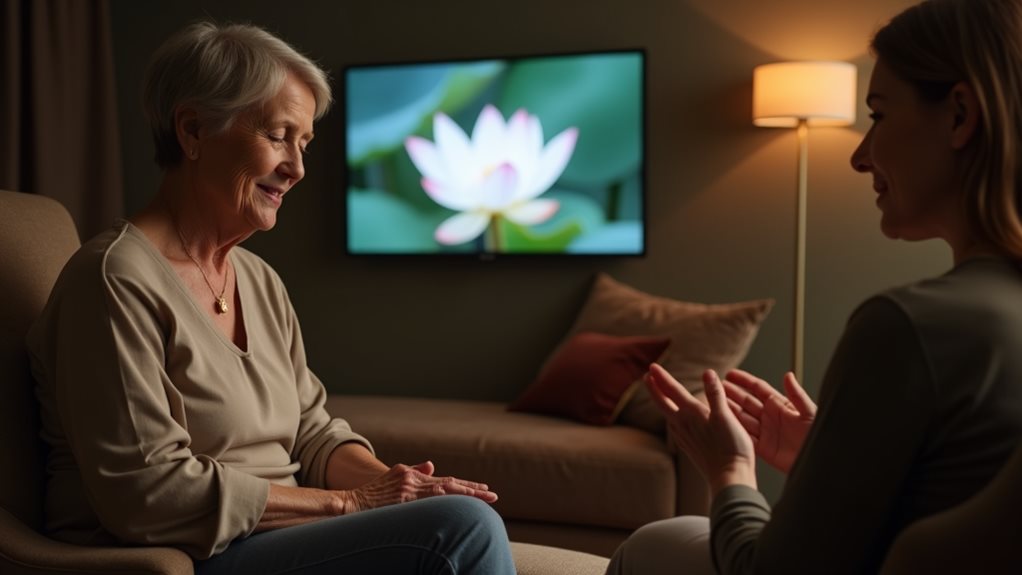
To conquer trypophobia, or the fear of holes, individuals can explore various therapeutic approaches including hypnosis, Emotional Freedom Technique (EFT), and Neuro-Linguistic Programming (NLP). These techniques aid in reprogramming fear responses, managing emotional turmoil, and fostering new, positive perceptions. Enlisting professional help and joining support groups can also enhance coping strategies, providing a foundation for lasting recovery and emotional resilience. Further exploration into these approaches offers deeper insights into effectively managing this phobia.
Key Takeaways
- Explore therapeutic approaches like Hypnosis, Emotional Freedom Technique (EFT), and Neuro-Linguistic Programming (NLP) to reframe and manage your fear.
- Engage in Cognitive Behavioral Therapy or exposure therapy to gradually decrease sensitivity to trypophobia triggers.
- Utilize self-help resources such as books and online guides to develop personal coping strategies and gain independence in managing your fear.
- Join a support group to connect with others who share similar experiences and receive emotional support and encouragement.
- Regularly practice relaxation techniques and mindfulness to alleviate anxiety and strengthen emotional resilience against phobic reactions.
Understanding the Nature of Trypophobia
Trypophobia, characterized by an intense aversion to clusters of small holes or bumps, taps deeply into the psychological domain of fear and disgust.
This phobia's triggers, such as lotus seed pods, honeycombs, and aerated chocolates, evoke an almost primal fear in some individuals. The psychological impact of trypophobia can be profound, leading to severe anxiety, distress, and avoidance behaviors that can disrupt daily functioning.
Understanding these triggers is essential for managing this condition. By acknowledging and analyzing the specific patterns that cause discomfort, sufferers can begin to develop coping mechanisms that minimize the phobia's impact on their lives.
The Role of Hypnosis in Overcoming Phobias
Understanding the triggers of trypophobia provides a foundation for exploring therapeutic options that address the deeply rooted fears associated with this condition. Hypnosis techniques play a pivotal role in this therapeutic landscape, focusing primarily on subconscious reprogramming. This process allows individuals to confront and reframe their fears in a controlled environment, gradually altering their instinctual reactions to phobia triggers.
| Technique | Description | Benefit |
|---|---|---|
| Deep Relaxation | Calms the mind | Eases fear response |
| Subconscious Access | Engages deeper mind layers | Facilitates lasting change |
| Thought Reframing | Reinterprets fear stimuli | Reduces phobic reactions |
| Safe Environment | Controlled exposure | Builds coping skills |
| Progressive Therapy | Gradual desensitization | Enhances overall wellbeing |
This approach combines scientific rigour with empathy, providing a transformative pathway for those grappling with trypophobia.
Benefits of Emotional Freedom Technique (EFT) for Trypophobia

The Emotional Freedom Technique (EFT) offers a significant therapeutic advantage for individuals afflicted with trypophobia, utilizing a non-invasive method that focuses on tapping specific meridian points to alleviate emotional distress.
This approach integrates several key benefits:
- Emotional Release: EFT techniques facilitate the release of deep-seated emotions linked to trypophobia, enhancing stress reduction and anxiety relief.
- Fear Management: Regular application of tapping points helps manage and reduce the intensity of fear responses, promoting holistic healing.
- Self Empowerment: Users gain tools for self-managed care, boosting confidence and control over their phobic reactions and contributing to long-term well-being.
NLP Strategies for Managing Fear Responses
Neuro-Linguistic Programming (NLP) offers innovative strategies for effectively managing fear responses, particularly in individuals struggling with trypophobia. NLP techniques such as Fear Reframing, Anchoring Methods, and Visualization Exercises enhance emotional resilience and facilitate response management. These methods empower individuals to alter their emotional reactions to fear-inducing stimuli, promoting a more resourceful state of mind.
| Technique | Benefit |
|---|---|
| Fear Reframing | Changes perception of fearful stimuli |
| Anchoring Methods | Instills calming responses |
| Visualization Exercises | Promotes emotional control & resilience |
This approach provides a structured way to rebuild confidence and manage responses more effectively.
How Therapy Can Help Children and Adolescents With Trypophobia

Many children and adolescents with trypophobia experience significant distress due to their intense aversion to clusters of small holes or bumps.
Therapy can be pivotal in addressing these fears through structured therapeutic engagement, focusing on reshaping childhood experiences related to fear.
Key therapeutic interventions include:
- Cognitive Behavioral Therapy (CBT): Helps modify negative thoughts and behaviors associated with trypophobia.
- Exposure Therapy: Gradually introduces the phobic stimuli in a controlled manner to desensitize the individual.
- Play Therapy: Utilizes creative play to safely explore and express emotions, facilitating emotional healing and coping strategies.
These approaches collectively foster resilience and emotional well-being in young individuals.
The Impact of a Holistic Approach on Fear Treatment
While traditional methods often focus on isolated symptoms, a holistic approach to fear treatment integrates various therapeutic modalities, addressing the multifaceted nature of phobias such as trypophobia.
Holistic healing views the individual as a whole, considering physical, emotional, and psychological dimensions. This thorough perspective guarantees that fear management is not just about suppressing symptoms but nurturing resilience and overall mental health.
Techniques like hypnosis, EFT, and NLP are combined to explore the root causes, promote emotional release, and reframe negative perceptions.
Such an approach not only alleviates immediate distress but also empowers sustained recovery and well-being.
Empowering Results From Integrative Therapy Techniques

Integrative therapy techniques, when combined, yield empowering results that substantially transform the lives of individuals grappling with trypophobia.
These empowering techniques enhance emotional resilience, offering a renewed sense of control and well-being.
The following list highlights key outcomes:
- Self-discovery: Individuals gain insight into their fear mechanisms, enhancing understanding and management.
- Emotional healing: Deep, enduring emotional release from phobia-related traumas fosters recovery.
- Personal empowerment: Skills and strategies acquired lead to improved self-efficacy, enabling individuals to face and overcome their fears with confidence.
Such integrative approaches substantially ameliorate the psychological distress associated with trypophobia, promoting a healthier, more fulfilling life.
Enhancing Treatment Effectiveness With Lifestyle Changes
Building on the substantial benefits of integrative therapy techniques for managing trypophobia, incorporating specific lifestyle changes can further enhance treatment effectiveness.
Lifestyle modifications such as adopting a balanced diet, engaging in regular physical activity, and practicing mindfulness can markedly support the therapeutic process.
These adjustments contribute to overall well-being and stress reduction, creating a more resilient psychological foundation. By stabilizing the individual's emotional state, these changes not only mitigate the immediate symptoms of trypophobia but also reinforce the coping mechanisms developed during therapy, leading to sustained improvement and a higher quality of life.
Steps to Begin Your Journey Towards Healing

Starting on the path to overcoming trypophobia begins with recognizing the need for professional intervention and committing to the process of therapeutic engagement.
This self-discovery journey, pivotal for emotional healing, relies on several key steps:
- Acknowledgment: Accepting that the fear of holes affects one's life and emotional well-being.
- Professional Help: Seeking therapists who specialize in phobias to guide the healing process.
- Therapeutic Techniques: Engaging in targeted therapies such as Cognitive Behavioral Therapy (CBT), which helps reshape negative thought patterns associated with trypophobia.
This structured approach encourages a deeper understanding and management of the phobia, leading to lasting emotional recovery.
Additional Resources for Coping With Trypophobia
Upon establishing a professional support system and engaging in therapeutic techniques for trypophobia, individuals may benefit from exploring additional resources designed to complement and enhance their coping strategies. Delving into self-help techniques and joining support groups can offer significant benefits. These resources provide practical guidance and foster a community of understanding that can further alleviate the psychological distress associated with trypophobia.
| Resource Type | Benefit | Availability |
|---|---|---|
| Self-help Techniques | Empowers personal management | Books, Online Guides |
| Support Groups | Community support, shared experiences | Local, Online |
| Educational Materials | Increases understanding of trypophobia | Libraries, Websites |
These tools collectively empower individuals to manage their condition more effectively.
Frequently Asked Questions
How Common Is Trypophobia Among the General Population?
Trypophobia statistics indicate its prevalence varies, with significant psychological triggers impacting individuals differently. Scientific studies suggest a low to moderate occurrence, reflecting diverse emotional responses depending on personal experiences and psychological predispositions.
Can Trypophobia Affect Animals as Well as Humans?
Opening Pandora's box of phobias, trypophobia may indeed influence animals, altering their natural behavior and eliciting fear responses similar to those observed in humans, thereby bridging the gap between human and animal psychological experiences.
Are There Any Geographical Variations in Trypophobia Prevalence?
Research indicates that trypophobia prevalence may vary by region, potentially influenced by cultural perceptions and local environmental factors. Regional studies are needed to better understand these geographical variations and their underlying causes.
What Are the Long-Term Health Impacts of Untreated Trypophobia?
Untreated trypophobia may lead to escalating long-term anxiety and psychological distress. Persistent exposure without intervention can profoundly affect daily functioning, increasing risk of chronic stress and impacting overall mental health stability.
How Do Cultural Differences Influence the Perception of Trypophobia?
Cultural differences greatly impact how trypophobia is perceived, with variations in cultural symbolism and fear expression influencing individual reactions. These factors shape the psychological and emotional responses to feared patterns across diverse populations.
Conclusion
As the sun sets on the horizon, casting a gentle glow that softens the stark edges of fear, individuals grappling with trypophobia find solace. The therapeutic landscape, enriched with hypnosis, EFT, and NLP, offers a sanctuary where the mind's tangled fears are untwined. Each step taken towards healing is a leaf turned over, revealing a new, resilient self, ready to embrace a life unmarred by the haunting shadows of clustered holes, paving a path to serene liberation.





